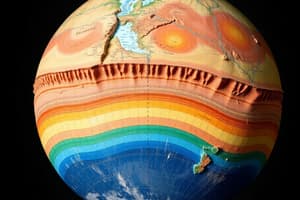Podcast
Questions and Answers
What layer beneath the lithosphere allows for the movement of tectonic plates?
What layer beneath the lithosphere allows for the movement of tectonic plates?
- Mantle
- Crust
- Asthenosphere (correct)
- Core
Which type of plate boundary is characterized by plates moving apart and creating new crust?
Which type of plate boundary is characterized by plates moving apart and creating new crust?
- Convergent Boundaries
- Subduction Zones
- Transform Boundaries
- Divergent Boundaries (correct)
Which geological feature is most likely formed as a result of convergent plate boundaries?
Which geological feature is most likely formed as a result of convergent plate boundaries?
- Mid-Atlantic Ridge
- Ocean Basins
- Mountain Ranges (correct)
- Fault Lines
What mechanism primarily drives the movement of tectonic plates?
What mechanism primarily drives the movement of tectonic plates?
Which evidence supports the theory of plate tectonics through the alignment of magnetic minerals in rocks?
Which evidence supports the theory of plate tectonics through the alignment of magnetic minerals in rocks?
Which of the following represents the concept of subduction in plate tectonics?
Which of the following represents the concept of subduction in plate tectonics?
What is a primary result of transform plate boundaries?
What is a primary result of transform plate boundaries?
How does the theory of plate tectonics impact Earth's climate over geological timescales?
How does the theory of plate tectonics impact Earth's climate over geological timescales?
Flashcards are hidden until you start studying
Study Notes
Plate Tectonics Theory
-
Definition: A scientific theory explaining the movement of Earth's lithosphere (the rigid outer layer of the Earth) which is divided into tectonic plates.
-
Key Concepts:
- Lithosphere: Comprises the crust and the uppermost mantle; rigid and brittle.
- Asthenosphere: Layer beneath the lithosphere; semi-fluid and allows for the movement of tectonic plates.
-
Plate Movement:
- Tectonic plates move due to convection currents in the mantle.
- Movement can be driven by:
- Heat from the Earth’s interior.
- Gravity pulling plates downward at subduction zones.
-
Types of Plate Boundaries:
-
Divergent Boundaries:
- Plates move apart.
- Creates new crust as magma rises.
- Example: Mid-Atlantic Ridge.
-
Convergent Boundaries:
- Plates collide or move towards each other.
- Can form mountain ranges, deep ocean trenches, or volcanic arcs.
- Example: Himalayas (continental-continental) or Mariana Trench (oceanic-continental).
-
Transform Boundaries:
- Plates slide past each other horizontally.
- Causes earthquakes due to stress accumulation.
- Example: San Andreas Fault in California.
-
-
Plate Interactions:
- Subduction: One plate descends beneath another, often creating volcanic activity.
- Rifting: Plates pull apart, leading to the formation of new ocean basins.
- Faulting: Fractures in the Earth's crust where movement occurs; can create earthquakes.
-
Evidence Supporting Plate Tectonics:
- Fossil Distribution: Similar fossils found on different continents.
- Fit of Continents: Coastlines of continents, such as South America and Africa, fit together.
- Seafloor Spreading: New crust formed at mid-ocean ridges suggests movement.
- Paleomagnetism: Magnetic minerals in rocks align with Earth’s magnetic field, showing historical movement.
-
Impact on Earth’s Features:
- Creation of mountains, earthquakes, and volcanic activity.
- Influence on climate and ocean currents over geological timescales.
-
Importance of the Theory:
- Provides framework for understanding geological processes.
- Links surface geology with deeper Earth processes.
- Essential for predicting natural disasters and understanding Earth’s history.
Plate Tectonics Theory
- Definition: Explains the movement of Earth's lithosphere, which is divided into tectonic plates.
- Lithosphere: Consists of the Earth's crust and the upper mantle; characterized as rigid and brittle.
- Asthenosphere: Situated beneath the lithosphere; semi-fluid layer facilitating tectonic plate movement.
- Driving Forces for Plate Movement:
- Convection currents in the mantle caused by heat from the Earth's interior.
- Gravity’s role in pulling plates downward at subduction zones.
Types of Plate Boundaries
-
Divergent Boundaries:
- Occur where plates move apart, leading to the creation of new crust as magma rises.
- Example: Mid-Atlantic Ridge, which actively forms new ocean floor.
-
Convergent Boundaries:
- Occur when plates collide or approach each other.
- Result in mountains, deep ocean trenches, or volcanic arcs.
- Notable examples include the Himalayas (caused by continental-continental collision) and the Mariana Trench (formed by oceanic-continental collision).
-
Transform Boundaries:
- Occur when plates slide horizontally past each other.
- Generate significant earthquake activity as stress accumulates.
- Example: San Andreas Fault in California is a well-known transform boundary.
Plate Interactions
- Subduction: One tectonic plate descends beneath another, often resulting in volcanic activity and the formation of trenches.
- Rifting: Plates pulling apart can lead to the creation of new ocean basins.
- Faulting: Occurs when there are fractures in the Earth's crust where movement takes place, often resulting in earthquakes.
Evidence Supporting Plate Tectonics
- Fossil Distribution: Identical fossils found on disparate continents hint at previously connected landmasses.
- Fit of Continents: Geographic coasts of continents like South America and Africa exhibit a complementary shape.
- Seafloor Spreading: The formation of new crust at mid-ocean ridges indicates continual plate motion.
- Paleomagnetism: Magnetic minerals in rocks align with Earth’s magnetic field and provide clues about historical plate movement.
Impact on Earth’s Features
- Geological Consequences: The movement and interactions of tectonic plates result in the formation of mountains, initiation of earthquakes, and eruption of volcanoes.
- Long-term Effects: Influences on global climate and ocean currents across geological time scales.
Importance of the Theory
- Serves as a foundational framework for understanding various geological processes.
- Connects surface geological features with processes occurring within the Earth.
- Crucial for predicting natural disasters and comprehending the planet's geological history.
Studying That Suits You
Use AI to generate personalized quizzes and flashcards to suit your learning preferences.




